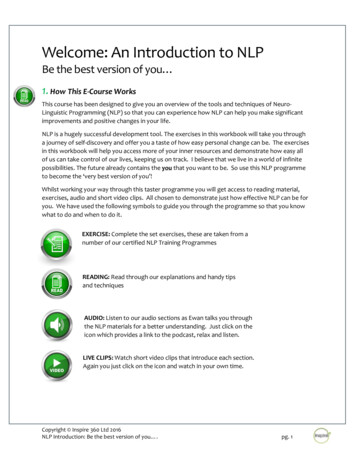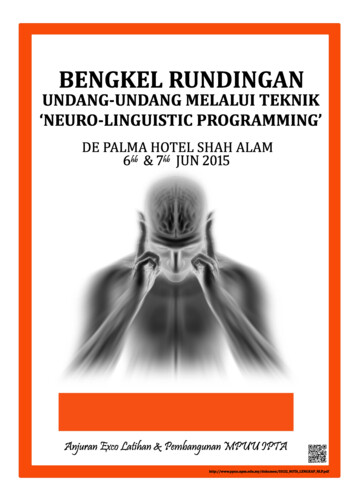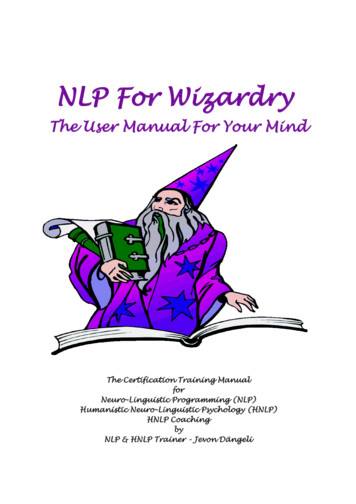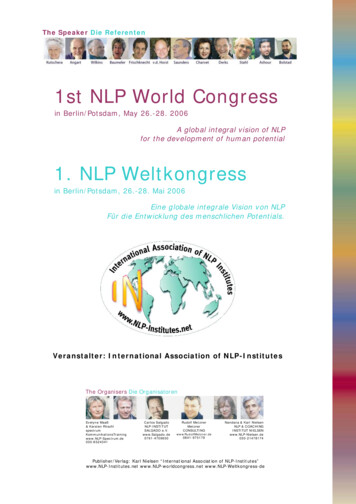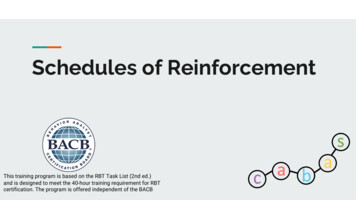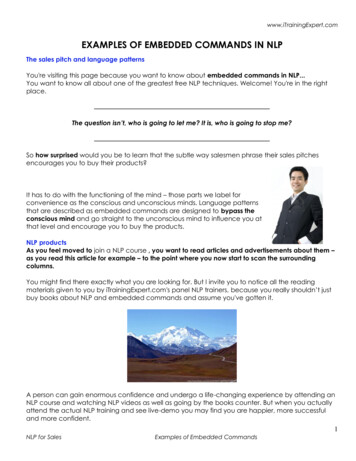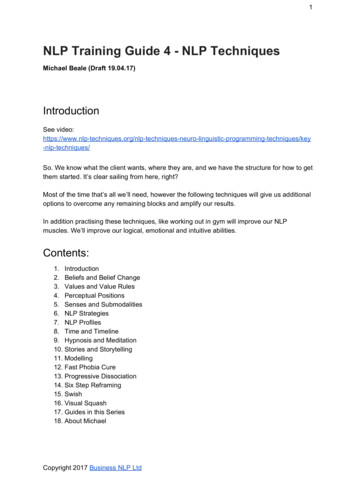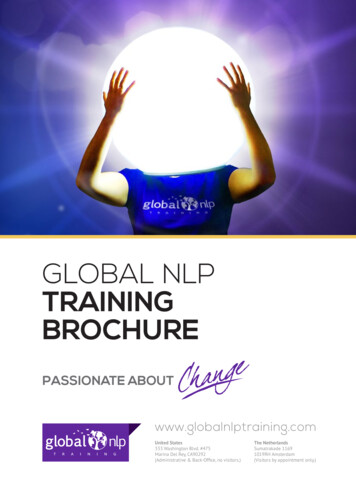
Transcription
Reinforcement Learning for NLPAdvanced Machine Learning for NLPJordan Boyd-GraberREINFORCEMENT OVERVIEW, POLICY GRADIENTAdapted from slides by David Silver, Pieter Abbeel, and John SchulmanAdvanced Machine Learning for NLP Boyd-GraberReinforcement Learning for NLP 1 of 1
I used to say that RL wasn’t used in NLP . . . Now it’s all over the place Part of much of ML hype But what is reinforcement learning?Advanced Machine Learning for NLP Boyd-GraberReinforcement Learning for NLP 2 of 1
I used to say that RL wasn’t used in NLP . . . Now it’s all over the place Part of much of ML hype But what is reinforcement learning? RL is a general-purpose framework for decision-makingRL is for an agent with the capacity to actEach action influences the agent’s future stateSuccess is measured by a scalar reward signalGoal: select actions to maximise future rewardAdvanced Machine Learning for NLP Boyd-GraberReinforcement Learning for NLP 2 of 1
At each step t the agent: Executes action a t Receives observation ot Receives scalar reward rt The environment: Receives action a t Emits observation ot 1 Emits scalar reward rt 1Advanced Machine Learning for NLP Boyd-GraberReinforcement Learning for NLP 3 of 1
ExampleStateRewardActionsQAWords SeenAnswer AccuracyAnswer / WaitAdvanced Machine Learning for NLP Boyd-GraberMTForeign Words SeenTranslation QualityTranslate / WaitReinforcement Learning for NLP 4 of 1
State Experience is a sequence of observations, actions, rewardso1 , r1 , a 1 , . . . , a t 1 , ot , rt(1) The state is a summary of experiencest f (o1 , r1 , a 1 , . . . , a t 1 , ot , rt )(2) In a fully observed environmentst f (ot )Advanced Machine Learning for NLP Boyd-Graber(3)Reinforcement Learning for NLP 5 of 1
What makes an RL agent? Policy: agent’s behaviour function Value function: how good is each state and/or action Model: agent’s representation of the environmentAdvanced Machine Learning for NLP Boyd-GraberReinforcement Learning for NLP 6 of 1
Policy A policy is the agent’s behavior It is a map from state to action: Deterministic policy: a π(s ) Stochastic policy: π(a s ) p (a s )Advanced Machine Learning for NLP Boyd-GraberReinforcement Learning for NLP 7 of 1
Value Function A value function is a prediction of future reward: “How much reward will Iget from action a in state s?” Q -value function gives expected total reward from state s and action a under policy π with discount factor γ (future rewards mean less than immediate) Q π (s , a ) E rt 1 γrt 2 γ2 rt 3 . . . s , aAdvanced Machine Learning for NLP Boyd-Graber(4)Reinforcement Learning for NLP 8 of 1
A Value Function is Great! An optimal value function is the maximum achievable valueQ (s , a ) max Q π (s , a ) Q π (s , a ) π(5) If you know the value function, you can derive policyπ arg max Q (s , a )aAdvanced Machine Learning for NLP Boyd-Graber(6)Reinforcement Learning for NLP 9 of 1
Approaches to RLValue-based RL Estimate the optimal value function Q (s , a ) This is the maximum value achievable under any policyPolicy-based RL Search directly for the optimal policy π This is the policy achieving maximum future rewardModel-based RL Build a model of the environment Plan (e.g. by lookahead) using modelAdvanced Machine Learning for NLP Boyd-GraberReinforcement Learning for NLP 10 of 1
Deep Q Learning Optimal Q -values should obey equation Q (s , a ) Es 0 r γQ (s 0 , a 0 ) s , a(7) Treat as regression problem 2 Minimize: r γ maxa Q (s 0 , a 0 , w ) Q (s , a , w ) Converges to Q using table lookup representation But diverges using neural networks due to: Correlations between samples Non-stationary targetsAdvanced Machine Learning for NLP Boyd-GraberReinforcement Learning for NLP 11 of 1
Deep RL in AtariAdvanced Machine Learning for NLP Boyd-GraberReinforcement Learning for NLP 12 of 1
DQN in Atari End-to-end learning of values Q (s , a ) from pixels s Input state s is stack of raw pixels from last four frames Output is Q (s , a ) for 18 joystick/button positions Reward is change in score for that stepAdvanced Machine Learning for NLP Boyd-GraberReinforcement Learning for NLP 13 of 1
Atari ResultsAdvanced Machine Learning for NLP Boyd-GraberReinforcement Learning for NLP 14 of 1
Policy-Based RL Advantages: Better convergence properties Effective in high-dimensional or continuous action spaces Can learn stochastic policies Disadvantages: Typically converge to a local rather than global optimum Evaluating a policy is typically inefficient and high varianceAdvanced Machine Learning for NLP Boyd-GraberReinforcement Learning for NLP 15 of 1
Optimal Policies Sometimes StochasticAdvanced Machine Learning for NLP Boyd-GraberReinforcement Learning for NLP 16 of 1
Optimal Policies Sometimes Stochastic(Cannot distinguish gray states)Advanced Machine Learning for NLP Boyd-GraberReinforcement Learning for NLP 16 of 1
Optimal Policies Sometimes StochasticDeterministic(Cannot distinguish gray states)Advanced Machine Learning for NLP Boyd-GraberReinforcement Learning for NLP 16 of 1
Optimal Policies Sometimes StochasticDeterministic(Cannot distinguish gray states)Value-based RL learns near deterministic policy!Advanced Machine Learning for NLP Boyd-GraberReinforcement Learning for NLP 16 of 1
Optimal Policies Sometimes StochasticStochastic(Cannot distinguish gray states, so flip a coin!)Advanced Machine Learning for NLP Boyd-GraberReinforcement Learning for NLP 16 of 1
Likelihood Ratio Policy GradientLet τ be state-action s0 , u 0 , . . . , sH , u H . Utility of policy π parametrized byθ is U (θ ) Eπθ ,UHXR (st , u t ); πθ tXP (τ; θ )R (τ).(8)tauOur goal is to find θ :max U (θ ) maxθAdvanced Machine Learning for NLP Boyd-GraberθXp (τ; θ )R (τ)(9)tReinforcement Learning for NLP 17 of 1
Likelihood Ratio Policy GradientXp (τ; θ )R (τ)(10)tTaking the gradient wrt θ :(11)Advanced Machine Learning for NLP Boyd-GraberReinforcement Learning for NLP 18 of 1
Likelihood Ratio Policy GradientXp (τ; θ )R (τ)(10)tTaking the gradient wrt θ : θ U (θ ) XτR (τ)P (τ; θ ) θ P (τ; θ )P (τ; θ )(11)(12)Move differentiation inside sum (ignore R (τ) and then add in term thatcancels outAdvanced Machine Learning for NLP Boyd-GraberReinforcement Learning for NLP 18 of 1
Likelihood Ratio Policy GradientXp (τ; θ )R (τ)(10)tTaking the gradient wrt θ : θ U (θ ) X XττR (τ)P (τ; θ ) θ P (τ; θ )P (τ; θ )(11) θ P (τ; θ )R (τ)P (τ; θ )(12)P (τ; θ )(13)Move derivative over probabilityAdvanced Machine Learning for NLP Boyd-GraberReinforcement Learning for NLP 18 of 1
Likelihood Ratio Policy GradientXp (τ; θ )R (τ)(10)tTaking the gradient wrt θ : θ U (θ ) XτR (τ)P (τ; θ ) θ P (τ; θ )P (τ; θ )(11) θ P (τ; θ )R (τ)P (τ; θ )τX P (τ; θ ) θ log P (τ; θ ) R (τ) XP (τ; θ )(12)(13)τAssume softmax formAdvanced Machine Learning for NLP Boyd-GraberReinforcement Learning for NLP 18 of 1
Likelihood Ratio Policy GradientXp (τ; θ )R (τ)(10)tTaking the gradient wrt θ : Xτ P (τ; θ ) θ log P (τ; θ ) R (τ)(11)Approximate with empirical estimate for m sample paths from π θ U (θ ) Advanced Machine Learning for NLP Boyd-Graberm1 X θ log P (r i ; θ )R (τi )m 1(12)Reinforcement Learning for NLP 18 of 1
Policy Gradient Intuition Increase probability of paths with positive R Decrease probability of paths with negagive RAdvanced Machine Learning for NLP Boyd-GraberReinforcement Learning for NLP 19 of 1
Extensions Consider baseline b (e.g., path averaging) θ U (θ ) m1 X θ log P (r i ; θ )(R (τi ) b (τ))m 1(13) Combine with value estimation (critic) Critic: Updates action-value function parameters Actor: Updates policy parameters in direction suggested by criticAdvanced Machine Learning for NLP Boyd-GraberReinforcement Learning for NLP 20 of 1
Reinforcement Learning for NLP Advanced Machine Learning for NLP Jordan Boyd-Graber REINFORCEMENT OVERVIEW, POLICY GRADIENT Adapted from slides by David Silver, Pieter Abbeel, and John Schulman


